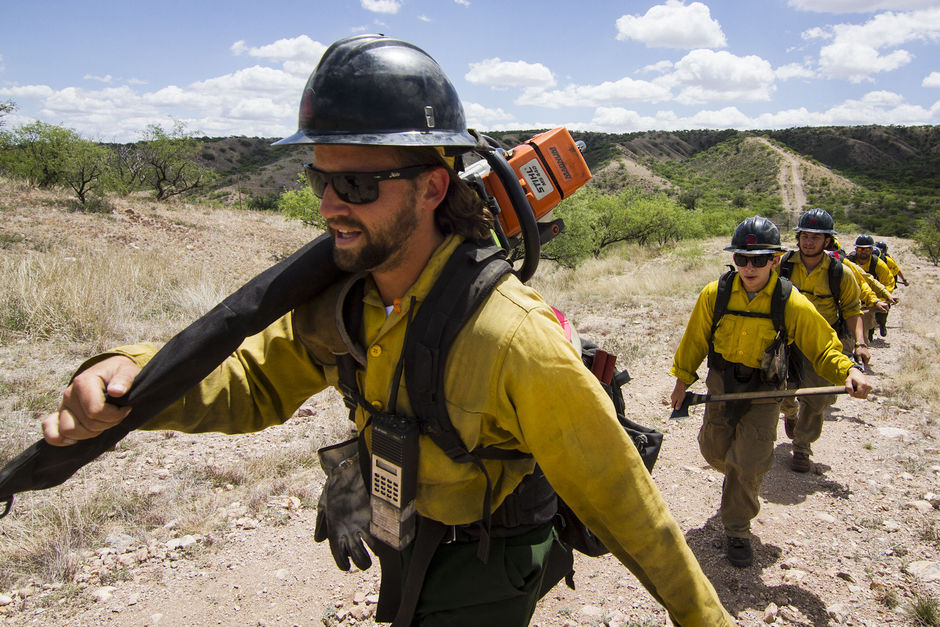Taken From, https://www.nogalesinternational.com/
Forest Service crew preps for wildfire season
“So which hill are we going up?” U.S. Forest Service firefighter Tony Young asked with a wry smile at the base of a short but punishingly steep hill off of Ruby Road Tuesday morning.
Jorge Amaya, who has been the superintendent for the Nogales-based 10-man squad for about eight years, nodded toward the obvious answer.
Wearing their signature fire-resistant green pants and yellow shirts and weighed down by heavy packs, hand tools and a saw, Amaya’s firefighters then trudged up to the summit where they had an informal discussion of what they would do if a blaze was racing up behind them.
Referring to the fire shelters that all wildland firefighters are required to carry, Amaya asked the crew where they would put their feet, “If we had to deploy, God forbid.”
“You want your feet toward the fire,” Young, a 22-year-old Douglas native, answered correctly.
With fire season just around the corner, Amaya and his crew are putting in hours of physical training and classroom learning to prepare themselves for another challenging half-year of work.
In wildland firefighting, deployments of two weeks or more are common and days on the fireline can exceed fourteen hours, meaning that firefighters need to be mentally and physically prepared for the taxing work. Including overtime, some wildland crews can put in well over 2,000 hours in a single season.
This crew put in just shy of 1,000 hours of overtime last season, several members said.
When paired with another 10-man squad based in Douglas, the 20-man team is the only USFS wildland hand crew in the Coronado National Forest (CNF), which includes Santa Cruz County, Amaya said.
Hand crews work to extinguish wildfires by digging fireline, which are strips or trenches of ground cleared of all flammable material, around blazes to control their spread.
Through late June or early July, the two squads are “committed” to the CNF, meaning they will stay in the area and be available for regional blazes, Amaya said. However, once monsoon rains come the crew is freed up to respond to fires across the West. Last year they went as far as Oregon and Washington, crew members said.
Among the more prominent local fires the crew has responded to in recent years are the 68,000-acre Murphy fire west of Interstate 19 in 2011, the cross-border Bull fire that same year, and the 2013 Soldier Basin Fire, which burned more than 10,000 acres five miles east of Nogales.
The National Interagency Fire Center is predicting a normal fire season in May for Southern Arizona and an above-normal season for southwest Arizona in June.
Spare time
When they’re waiting for fires, the crew does a lot of trail maintenance and range work in the county. Amaya said firefighters will conduct trail repair near Peña Blanca Lake in coming weeks.
Some of the crewmembers are locals, but most come from other parts of Arizona and out of state. The majority are in their 20s and are seasonal employees of the USFS.
Ben Como, a 20-year-old Phoenix native and Glendale Community College student, is starting his first year in fire with the crew. Earlier on Tuesday he successfully completed the so-called pack test, a prerequisite in which would-be employees must hike three miles with a 45-pound weighted vest in under 45 minutes.
Como, who finished in just under 43 minutes, said he first heard about working in wildfire while recently working with the Conservation Corps.
“As soon as I heard about it I started applying,” he said, adding that it was the “physical challenge” and time outdoors that drew him.
For Alex Starr, a 26-year-old Northern California native back for his second season with the crew, it was a change of scenery that made Nogales more appealing than the job he was offered in the Idaho panhandle.
“It’s just a completely different landscape than I’m used to,” he said, adding there’s also “good Mexican food down here.”
On the few days off he and his fellow firefighters get to enjoy between fires, Starr, who splits a cheap rental house in the county with crew member and Austin native Aaron “Mijo” Lopez, said he enjoys Nogales’ downtown area and the cultural quirks of being on the border.
“That’s why I’m back,” he said.
‘All a family’
Michael “Booster” Bustamante, 34, is one of the handful of locals on the crew. This is his second season with Amaya and he said the good pay during the summer and time off in the winter have been great for him and his family.
Bustamante said he’s able to support his wife and three kids with the pay, which he supplements with occasional work in the off-season, and getting the winter holidays off makes up for being away so much the other half of the year.
“It’s worth it,” he added. “You come back, get a good paycheck and get ready for the next fire.”
Entry-level firefighters can earn in excess of $40,000 during a heavy season.
Even when he’s on fires away from home, Bustamante said, the company of his fellow firefighters isn’t half bad.
“Right now, it’s all a family,” he said of his crew.
(Photo above by Murphy Woodhouse: Alex Starr, a sawyer with a Nogales-based wildfire crew, marches up a hill off of Ruby Road. His roommate Aaron “Mijo” Lopez is just behind him.)
Author: Murphy Woodhouse, Nogales International






































































